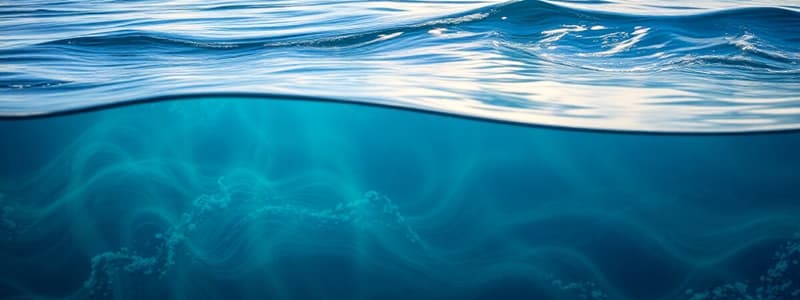Podcast
Questions and Answers
What primarily drives the deeper ocean currents?
What primarily drives the deeper ocean currents?
- Coriolis effect
- Differences in seawater density (correct)
- Prevailing winds
- Tidal forces
What role does the Gulf Stream play in the North Atlantic climate system?
What role does the Gulf Stream play in the North Atlantic climate system?
- It serves as the radiator for the North Atlantic. (correct)
- It prevents navigation in the Atlantic.
- It is the primary source of freshwater in the region.
- It cools the temperature of the ocean.
What is the maximum speed of the Gulf Stream when it starts near the Florida Current?
What is the maximum speed of the Gulf Stream when it starts near the Florida Current?
- 10 mph (~16 kph)
- 2 mph (~3.2 kph)
- 4 mph (~6.5 kph)
- 6 mph (~10 kph) (correct)
How does the Gulf Stream affect Europe's climate?
How does the Gulf Stream affect Europe's climate?
Which of the following describes the starting point of the Gulf Stream?
Which of the following describes the starting point of the Gulf Stream?
What role does the evaporation of warm water play in the Gulf Stream?
What role does the evaporation of warm water play in the Gulf Stream?
What causes the Gulf Stream to bend eastwards after reaching North Carolina?
What causes the Gulf Stream to bend eastwards after reaching North Carolina?
What phenomenon does the Gulf Stream contribute to, likened to a global conveyor belt?
What phenomenon does the Gulf Stream contribute to, likened to a global conveyor belt?
What initial condition allows water to be transported from the tropics to the North Atlantic?
What initial condition allows water to be transported from the tropics to the North Atlantic?
What is the significance of understanding the Gulf Stream's location for ship captains?
What is the significance of understanding the Gulf Stream's location for ship captains?
Flashcards
What is the Gulf Stream?
What is the Gulf Stream?
A powerful ocean current flowing from the Gulf of Mexico northward along the eastern coast of North America and then eastward towards Europe.
Why does a car's engine use water to cool down?
Why does a car's engine use water to cool down?
Its high heat capacity allows it to absorb a lot of heat without its temperature changing drastically. This makes it perfect for transferring heat away from the engine.
What impact does the Gulf Stream have on weather and climate?
What impact does the Gulf Stream have on weather and climate?
The Gulf Stream carries warm tropical water towards Europe, significantly influencing the climate of both sides of the Atlantic Ocean. It helps keep Western Europe warmer than it would be otherwise.
How does the Gulf Stream fit into the larger circulation of the North Atlantic?
How does the Gulf Stream fit into the larger circulation of the North Atlantic?
Signup and view all the flashcards
What forces drive the Gulf Stream?
What forces drive the Gulf Stream?
Signup and view all the flashcards
What drives the Gulf Stream?
What drives the Gulf Stream?
Signup and view all the flashcards
How does the Gulf Stream affect Europe's climate?
How does the Gulf Stream affect Europe's climate?
Signup and view all the flashcards
What happens to the Gulf Stream as it reaches the north?
What happens to the Gulf Stream as it reaches the north?
Signup and view all the flashcards
Why is the Gulf Stream important?
Why is the Gulf Stream important?
Signup and view all the flashcards
Study Notes
The Gulf Stream: A Deep Dive
-
Definition: The Gulf Stream is a major ocean current in the North Atlantic Ocean, carrying warm tropical water northward. It's part of a larger system of currents.
-
Origin and Path: Warm tropical seawater originates in the Gulf of Mexico and Caribbean Sea, beginning off the tip of Florida. It flows north along the eastern US coast, then bends eastward across the Atlantic towards Europe.
-
Role in Climate: The Gulf Stream acts as a "radiator" for the North Atlantic, transporting heat from the tropics to higher latitudes.
-
Driving Mechanisms: Surface currents are primarily driven by winds, while deeper currents are driven by density differences in seawater (temperature and salinity).
-
Gulf Stream Temperature and Properties:
-
Initially, it is very fast and warm (~86°F/30°C), but slows down and cools as it travels north.
-
It narrows and meanders as it progresses.
-
Width and depth vary, but the Gulf Stream can be measured as several hundred miles wide and 4,000 feet deep in places.
-
Influence on European Climate: The Gulf Stream significantly moderates the climate of Europe, providing "remote heating" as it warms the air and water. Temperatures in Europe are similar to areas at much higher latitudes due to the warm water.
-
Impact on Winds and Storms: The Gulf Stream's warm waters cause increased atmospheric humidity and energy. Storms, including hurricanes, can develop and strengthen over the warm water.
-
Importance for Navigation: The Gulf Stream is important for ship navigation; captains learn to use the current's direction to their advantage; early recordings like Franklin's charts highlighted the current's strength and function.
-
Gulf Stream's Flow Comparison: The Gulf Stream is proportionally equivalent to almost 100 times the flow of all terrestrial rivers combined.
-
Flow and Connection to Deep Sea Circulation: Part of the current eventually sinks to the bottom of the ocean as it becomes denser and colder causing the Atlantic to form a global conveyor belt affecting climate globally.
-
Potential for Hydropower: The Gulf Stream's strength and water movement has prompted ideas on using it for hydropower, though its future depends on climate changes.
-
Threats to the Gulf Stream: A warming climate leads to more glacier melt and freshwater influx in the North Atlantic. This influx of freshwater can potentially slow or disrupt the Gulf Stream's function.
Studying That Suits You
Use AI to generate personalized quizzes and flashcards to suit your learning preferences.




